

William Stopford
2025 Chevrolet Silverado ZR2 review
1 Month Ago
The Amarok V6 may be getting on a bit, but its strong points help maintain its appeal today – if you can look past its safety omissions.



Marketplace Editor
New from
$38,490
excl. on-roads

Marketplace Editor
New from
$38,490
excl. on-roads


Marketplace Editor
New from
$38,490
excl. on-roads

Marketplace Editor
New from
$38,490
excl. on-roads
Quickly see how this car stacks up against its competition. Select any benchmark to see more details.
Where expert car reviews meet expert car buying – CarExpert gives you trusted advice, personalised service and real savings on your next new car.
The ute segment has had a few shake ups in recent months – the all-new Isuzu D-Max and Mazda BT-50 have hit the market, the sales-leading Toyota HiLux and Ford Ranger have received a raft of upgrades, and new rivals from China loom.
The more that changes though, the more the Volkswagen Amarok stays the same, living on in the first-generation guise initially launched exactly a decade ago.
Despite celebrating its 10th birthday in 2020, the Volkswagen Amarok remains the only mainstream dual-cab ute in Australia with six-cylinder power. The Mercedes-Benz X-Class is headed for retirement, and the Ram 1500 V6 EcoDiesel is hardly mainstream at near $110,000.
With that in mind, let’s find out how the 2020 Volkswagen Amarok V6 SportlineTDI550 fares against its newer competition.

At $56,590 before on-road costs, the V6 Sportline is at the lower end of the Amarok V6 ladder, being just one step up from the more basic V6 Core specification which kicks off at a smidgen under $50,000 if you opt for the six-speed manual.
Further up the V6 range are the Canyon ($57,990), 580 Highline ($61,990), and finally the Highline Black 580 S ($70,990). All prices exclude on-road costs.
The Amarok V6 Sportline is a stone’s throw away from high-spec rivals such as the Ford Ranger XLT (from $57,440) and Toyota HiLux SR5 (from $57,920), as well as the Isuzu D-Max LS-U (from $56,900). Of course the Amarok Sportline has a V6, whereas the Ranger is a five-cylinder, and the HiLux and D-Max have four-cylinder engines.



Buy your new car without the stress. It's fast, simple and completely free.

Great service from Travis and team, second time I have used this business would not hesitate to recommend them to anyone
Craig C.
Purchased a Ford Ranger in Sunshine Coast, QLD
CarExpert helped Craig save $7,224 on his Ford Ranger, now let us save you on your next new car.
Get your BEST priceFor your spend, you get that 3.0-litre V6 turbo-diesel which has done service in Volkswagen Group models including the Audi Q7, Porsche Cayenne, and Volkswagen Touareg, in addition to specification highlights such as 18-inch alloy wheels, double-chrome bars in the front grille, a ‘Comfort’ tailgate, body-coloured side mirrors, rear privacy glass, a chrome rear bumper, and tinted tail lights.
Inside, there’s cloth upholstery, bright silver decorative inserts, dual-zone climate control, four 12V sockets (three in the cabin, one in the tray), and front parking sensors bolstering the standard rear sensors and reversing camera.
Speaking of carryover equipment, specification included from the V6 TDI550 Core and up includes extended wheel arches, halogen front fog lights, a monochrome multi-function driver cluster display, a 6.33-inch ‘Discover Media’ touchscreen infotainment system with Apple CarPlay and Android Auto, a leather-wrapped multifunction steering wheel, cruise control, and multi-collision braking.



If you want features like bi-xenon headlights with LED daytime running lights, inbuilt satellite navigation and the option of leather trim, you’ll need to step up to the V6 580 Highline or V6 580 S.
However, no Volkswagen Amarok offers the latest active safety and driver assistance features, meaning there’s no autonomous emergency braking, no lane-departure warning or lane-keeping assist, nor blind-spot monitoring with rear cross-traffic alert. There’s not even curtain airbags that extend to the second row.
Three or five years ago the Amarok’s spec sheet wouldn’t have lagged far behind the competition, but the lack of safety tech is a glaring omission as key rivals have these features as standard across the range.

The four-cylinder Volkswagen Amarok technically wears a five-star ANCAP safety rating, though it dates back to 2011, well before the latest and strictest crash-testing protocols were implemented.
ANCAP’s 2011-stamped rating is based on tests conducted by Euro NCAP in 2010, recording 32.99 out of 37 under the old scoring system.
However, as noted earlier the Amarok lacks a number of safety items that would be considered essential by most new vehicles today. Dual front, side curtain and side chest airbags feature in the front row but there’s no inflators protecting rear occupants – where kids are most likely to sit.

The lack of any active safety systems is a key miss compared to the competition, especially when rivals like the new D-Max and BT-50 not only offer forward AEB but also cross-traffic AEB and a front-centre airbag.
If you’re planning to use your dual-cab ute as a lifestyle vehicle or family runabout and safety is a priority, you may want to consider rival utes with a stronger set of safety features.

Hopping inside the Amarok, you’ll feel right at home if you’re coming from another Volkswagen model – especially if it’s an SUV or commercial model.
The overall layout has aged well thanks to its conventional design, though buyers with a taste for a more contemporary and flashy aesthetic may find the cockpit a little austere.
Despite the generic look, the Amarok’s cabin remains very functional while continuing to be one of the more upmarket options in the class.


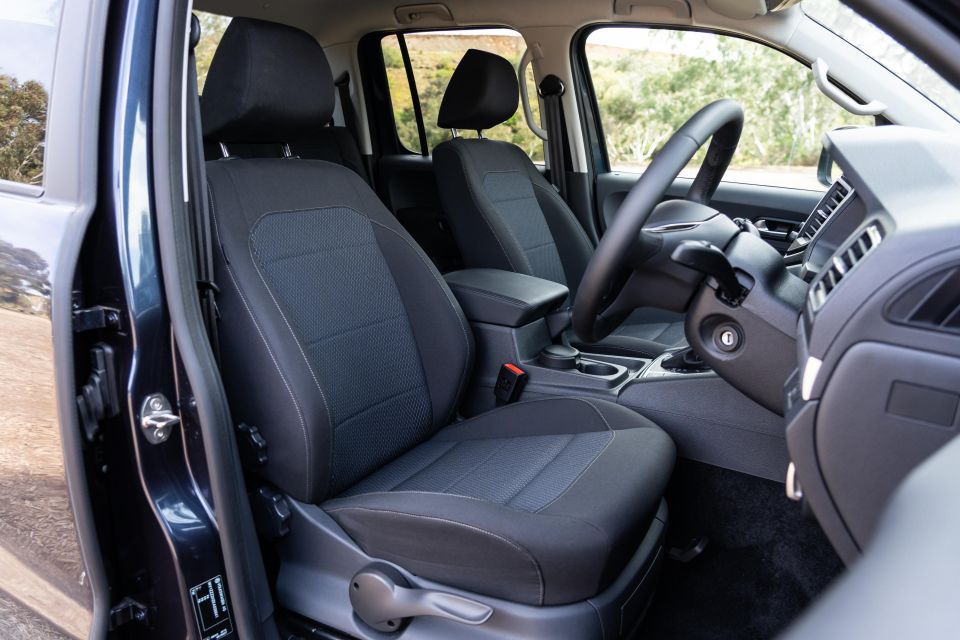
As is the case in most commercial vehicles, the materials and trims used throughout the cabin err towards durability as opposed to the more yielding soft-touch feel you might expect from a Volkswagen passenger car.
That said, the front seats are supportive and comfortable, and touch points like the steering wheel and gearshift are finished with soft leather like Volkswagen’s passenger models for an added dash of class. The elbow rests in the door have padded fabric inserts for added comfort, while the big centre armrest up front is nice and squishy as well.
Ahead of the driver, the monochrome supervision cluster display serves the same function as higher-spec colour units in other VW models, though it looks a little basic compared to rivals.
The 6.33-inch touchscreen sitting front and centre of the dashboard is familiar from older Volkswagen models, and while it lacks screen real estate compared to newer 8.0-inch screens in rival utes, the responsiveness and resolution remains above average in the segment.

Space and storage up front is pretty good, with a cubby under the centre stack for your phone and wallet, flock-lined door bins, and a large tray atop the dashboard with a 12V power socket. The actual storage area under the centre armrest is surprisingly small, as half the space is taken up by the manual handbrake housing.
Further back, the second row offers little in terms of amenities, but has decent space for passengers without being standout.
The Amarok’s width is excellent for broad-shouldered adults though legroom is cosy rather than capacious. Rear occupants miss out on air vents, but there is another 12V socket should you require a power outlet. Unlike the Ford Ranger, though, there’s no 230V inverter for beefier power equipment.
As noted earlier, there’s no curtain airbag coverage in the second row of seating, but there are ISOFIX anchorage points on the outboard pews.
The rear seat backrests fold if required, and the seat bases can also split 60:40 for added versatility.

As for the tray – a key part of buying a ute – it measures 1555mm deep and 1620mm wide, with 1222mm between the arches, and features a light system and 12V socket.
That means the Amarok’s load area can easily accommodate a standard 1165 x 1165mm Australian pallet, as well as a 1200 x 800mm European pallet. Also part of the Sportline specification is the ‘Comfort’ tailgate which makes opening and closing the tray easier, while still being rated to carry 200kg alone.
Under the tray is a multi-layer rigid axle with leaf springs and a stabiliser bar, while Volkswagen quotes a payload of 976kg for the V6 Sportline.
When fitted with a tow bar, the Amarok V6 (TDI550 and TDI580) can tow up to 3500kg (braked) with a tow bar load limit of 300kg. Volkswagen quotes a GVM of 3080kg and a GCM of 6000kg.
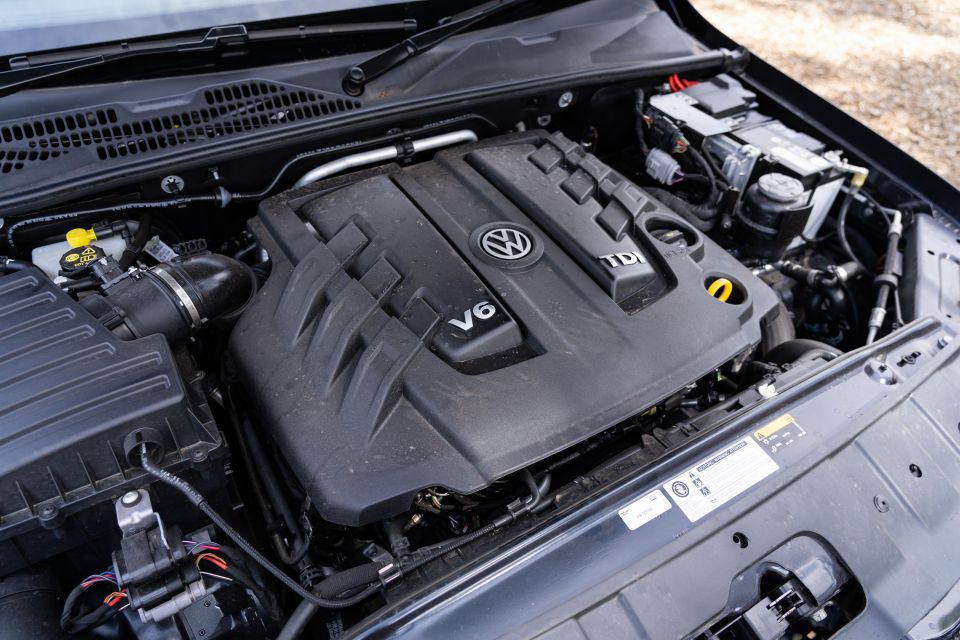
Power in Amarok V6 models comes from a 3.0-litre V6 single turbo diesel, available in three states of tune. In the TDI550 Sportline it develops 165kW of power between 2500 and 4500rpm, as well as a healthy 550Nm of torque from 1500 through to 2500rpm.
An overboost function bumps the power output in TDI550 models to 180kW for up to 10 seconds, also prolonging maximum torque delivery, according to Volkswagen. This feature comes on tap in third and fourth gear under hard acceleration, ideal for situations demanding quick bursts of power such as overtaking on the highway.
Running changes to the Amarok line-up earlier this year mean the Australian range is exclusively sourced from Argentina, which means all Amarok V6 models are Euro 5-certified – previously, TDI580 models hailed from Germany and featured a cleaner Euro 6 diesel with AdBlue.
Despite the changes, the TDI550 Amarok V6 still features a diesel particulate filter and catalytic converter, and claims to use 9.1 litres per 100 kilometres on the combined cycle.

In terms of performance, the V6 TDI550 Sportline claims to dash from 0-100km/h in a brisk 7.9 seconds, which is about half a second slower than the higher-spec TDI580 models (7.3 seconds).
Drive is sent to a permanent 4Motion all-wheel drive system via an eight-speed automatic transmission and Torsen locking differential. In typical driving, the Amarok runs a 40:60 front-rear torque split.
Unlike many rivals with selectable four-wheel drive systems and low-range transfer cases, the automatic Amarok automates these systems with the aforementioned permanent all-wheel drive setup and a first gear optimised for low-speed off-road driving.
On the topic of off-road driving, the Amarok’s built-in off-road mode tailors the ESP and ABS for off-road performance, and there’s hill-descent assist for steep declines too. There’s also a rear locking diff.

Despite its age, the Amarok continues to be one of the most refined drives in the class.
Even in this relatively basic specification, the V6-powered Volkswagen ute feels nice and refined across all driving situations, and rarely feels agricultural and clattery – which not all of its four-cylinder rivals can match.
In town the huge wave of low-down torque makes for effortless acceleration off the line, and keeping up with moving traffic is easy as pie.
It’s a similar story as the speeds rise, and regardless of whether you’re delicately pressing the accelerator or stomping on it to make a gap or overtake, the 3.0-litre V6 diesel and eight-speed auto combination is silky smooth and almost as refined as its application in the Volkswagen Group’s luxury SUVs.
There’s good insulation from engine, road, and wind noise across all situations, which is good news for those who need their ute to cover long distances over coarse-chip country highways. Comfortable seats and a settled high-speed ride further boost the Amarok’s appeal no doubt.
We noticed the leaf-sprung rear can get a little busy in town, though, and large hits at lower speeds can be quite jarring – but it’s far from the worst offender in the segment.
I personally love the steering feel in the Amarok. Despite being hydraulically assisted, the big VW ute offers relatively light steering that naturally weights up as you turn that feels more akin to a passenger car or SUV than rugged workhorse.
Volkswagen has done an excellent job making the Amarok feel car-like to drive. It actually doesn’t feel too different from a Touareg in many respects.
That said, you can’t escape the fact the Amarok is a big brute of a thing. At 5254mmlong and 1954mm wide, the Volkswagen ute is nearly 400mm longer than said Touareg, meaning it may test the limits of short parking spaces, and tight manoeuvres require that little bit of extra care.
Having a heavier hydraulic steering system also means three-point turns or tight reverse parks demand a little more steering input and physical effort from the driver.

Where expert car reviews meet expert car buying – CarExpert gives you trusted advice, personalised service and real savings on your next new car.
Once you’re off the black stuff, the Amarok’s full-time all-wheel drive system brings an added layer of surety on loose surfaces, which we experience first hand around our filming location near Werribee in Melbourne’s west.
As the terrain gets more challenging, the Amarok’s available off-road mode optimises the drivetrain for the tough stuff and is perfectly capable of driving through most situations the majority of owners would ever face.
With 192mm of ground clearance in V6 TDI550 guise, the Amarok is probably more road-biased compared to some of its rivals (as well as four-cylinder models which offer more than 220mm), but maintains a decent 500mm wading depth as well as approach/departure/ramp angles of 28, 23.6 and 23 degrees respectively.
Overall, the Amarok offers a good blend of on- and off-road capability which will appeal to a wide set of prospective buyers.
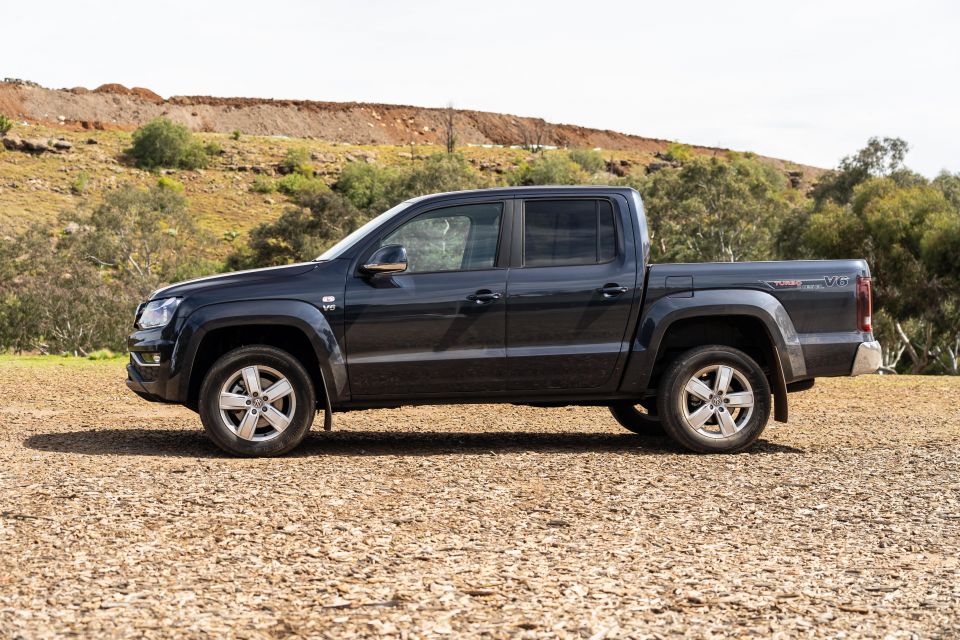
Like the wider Volkswagen line-up, the Amarok is covered by a five-year, unlimited-kilometre warranty with a year’s worth of roadside assistance and capped-price servicing for up to five years.
Volkswagen offers three- and five-year Care Plans allowing you to pay for your first three or five services upfront, saving hundreds of dollars compared to paying as you go.
The Amarok V6 requires servicing every 12 months or 15,000 kilometres, whichever comes first, with the three-year Care Plan costing $1450 while the five-year program is $2300 – the latter including a free first scheduled service and both including roadside assistance for the duration of the Care Plan.
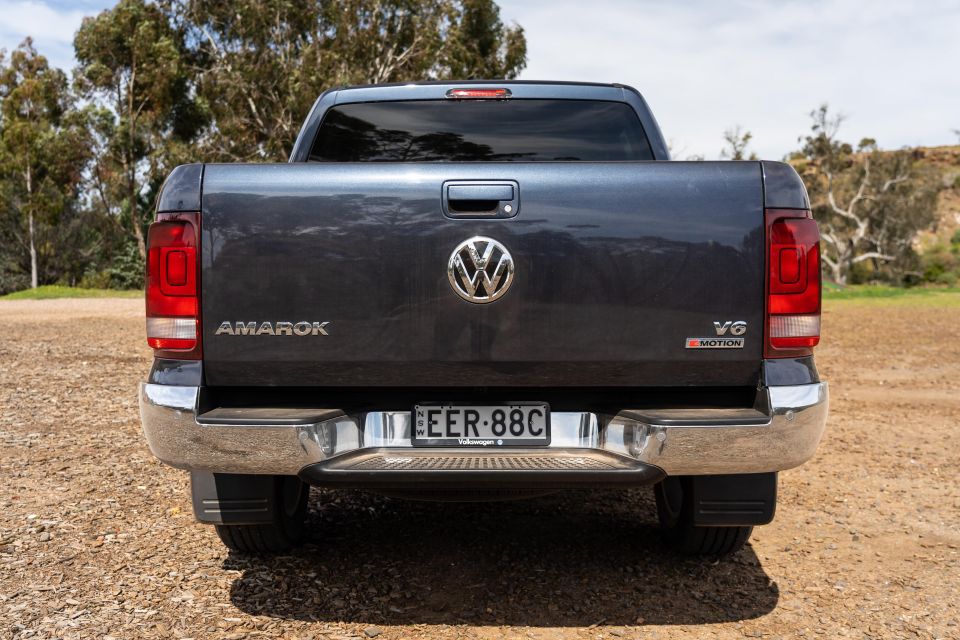
It’s still on the pricier side of the segment, especially when a 3.2-litre Ford Ranger 4×4 will set you back just $1591 over five years, and includes added benefits like ongoing satellite navigation map updates and roadside assistance yearly up to seven years.
As for fuel consumption, our tester drank an indicated 9.0L/100km of diesel over 418 kilometres of mixed driving, including decent stints on the freeway.
That equates to around almost 900 kilometres of real-world range from the Amarok’s 80-litre fuel tank, which could easily surpass 1000km with more freeway driving.

Buy your new car without the stress. It's fast, simple and completely free.

Great service from Travis and team, second time I have used this business would not hesitate to recommend them to anyone
Craig C.
Purchased a Ford Ranger in Sunshine Coast, QLD
CarExpert helped Craig save $7,224 on his Ford Ranger, now let us save you on your next new car.
Get your BEST priceFew vehicles can go a full decade and stay genuinely competitive among ever-evolving competition. Fortunately for the Volkswagen Amarok, it’s one of these few.
Safety shortcomings aside, the mature Amarok can still kick it with newer rivals in most respects, and maintains the unique selling point of offering a six-cylinder powertrain in the mainstream 4×4 ute segment that makes it top dog in the power and drivability stakes.
Its competent on-road manners and SUV-like drive also have kept it in the upper end of the class, as numerous rivals still struggle to find the balance between rugged capability and everyday usability.

As a technology and safety conscious buyer myself, however, and noting the family-friendly requirements of the modern ute buyer, it’s hard to recommend the Amarok over more contemporary utes like the Ford Ranger and Isuzu D-Max as they both offer comparable on-road refinement minus the V6 punch, and pack far more safety equipment backed by more recent five-star safety ratings.
With that in mind, should you not require the back seats often and be happy to miss out on the active safety net in place of class-leading performance, then it’s hard to go past the Amarok V6 – but spend that little extra on a Canyon or Highline.
Where expert car reviews meet expert car buying – CarExpert gives you trusted advice, personalised service and real savings on your next new car.
James is an automotive journalist based in Melbourne, Australia. Before joining CarExpert.com.au in 2020, James has worked at leading auto media outlets including Carsales and CarAdvice, as well as at Pulse agency for Ford Australia's communications team. In 2019 James made Mumbrella's 'Top 20 most prolific web authors in Australia' list after publishing 1,360 articles between March 1, 2018 and February 28, 2019 for CarAdvice. James is also an Ambassador for Drive Against Depression – an Australian charity whose mission is to support mental wellness through the freedom of driving and a shared love of cars.


William Stopford
1 Month Ago


Paul Maric
23 Days Ago


Max Davies
17 Days Ago


Josh Nevett
9 Days Ago
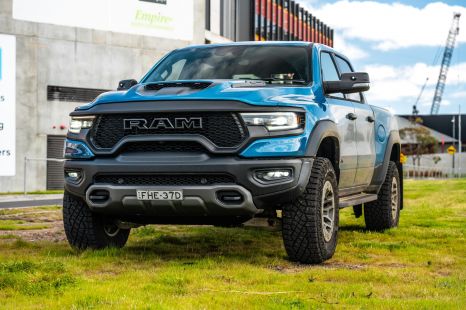

Max Davies
8 Days Ago


William Stopford
8 Days Ago